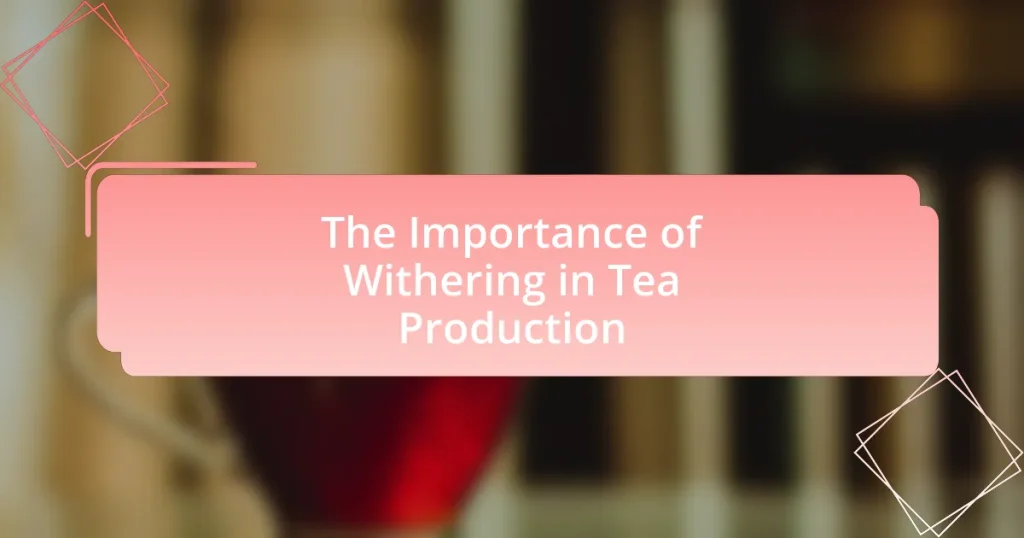The main entity of the article is the process of withering in tea production, which plays a crucial role in reducing moisture content and facilitating enzymatic reactions that enhance flavor and aroma. The article outlines how withering affects tea quality by concentrating essential oils and compounds, leading to improved taste profiles. It discusses the chemical changes that occur during withering, the various methods employed, and the impact of environmental factors on the process. Additionally, it highlights best practices for effective withering, common challenges faced by producers, and the signs of over or under withering in tea leaves. Overall, the article emphasizes the significance of withering as a vital step in achieving high-quality tea.

What is the role of withering in tea production?
Withering in tea production serves to reduce the moisture content of freshly plucked tea leaves, facilitating enzymatic reactions essential for flavor development. This process typically lasts several hours and allows the leaves to soften, making them more pliable for subsequent processing steps such as rolling and oxidation. Research indicates that withering can decrease moisture levels from around 80% to approximately 60%, which is crucial for achieving the desired taste and aroma profiles in the final tea product.
How does withering affect the quality of tea?
Withering significantly affects the quality of tea by reducing moisture content and initiating enzymatic processes that enhance flavor and aroma. During withering, the leaves lose water, which concentrates their essential oils and compounds, leading to a more robust taste profile. Research indicates that optimal withering conditions can increase the levels of catechins and amino acids, crucial for flavor development, while also reducing bitterness. For instance, studies have shown that withering for a specific duration can improve the overall sensory attributes of the tea, making it more appealing to consumers.
What chemical changes occur during the withering process?
During the withering process, enzymatic oxidation occurs, leading to the breakdown of chlorophyll and the formation of various aromatic compounds. This transformation is crucial as it enhances the flavor profile of the tea. Specifically, polyphenol oxidase (PPO) catalyzes the oxidation of catechins, resulting in the development of complex flavors and colors. Studies have shown that this enzymatic activity is essential for producing the desired characteristics in tea, as it influences both taste and aroma, making withering a vital step in tea production.
How does withering influence flavor and aroma in tea?
Withering significantly influences the flavor and aroma of tea by allowing moisture to evaporate from the leaves, which concentrates the essential oils and compounds responsible for these sensory attributes. During the withering process, enzymes become more active, leading to the oxidation of polyphenols, which enhances the complexity of flavors and aromas. Research indicates that withering can increase the concentration of volatile compounds, such as linalool and geraniol, which contribute floral and fruity notes to the tea. This transformation is crucial in developing the desired characteristics of various tea types, such as black, oolong, and green teas.
Why is withering considered a crucial step in tea processing?
Withering is considered a crucial step in tea processing because it reduces the moisture content of freshly plucked tea leaves, allowing for enzymatic reactions that develop flavor and aroma. This process typically involves spreading the leaves in a controlled environment to facilitate moisture loss, which can enhance the overall quality of the tea. Studies have shown that proper withering can significantly influence the chemical composition of the leaves, leading to improved taste profiles and higher market value.
What are the consequences of inadequate withering?
Inadequate withering in tea production leads to poor flavor development and reduced aroma in the final product. This occurs because withering is essential for reducing moisture content and initiating enzymatic processes that enhance the tea’s characteristics. When withering is insufficient, the leaves retain excess moisture, which can result in a grassy or astringent taste rather than the desired smoothness and complexity. Additionally, inadequate withering can hinder the oxidation process, leading to a less vibrant color and diminished health benefits associated with properly processed tea. Studies have shown that optimal withering conditions significantly improve the sensory qualities of tea, underscoring the critical role of this step in achieving high-quality tea.
How does withering impact the overall tea production process?
Withering significantly impacts the overall tea production process by reducing moisture content in fresh tea leaves, which is essential for enhancing flavor and aroma. This initial step allows enzymes to activate, initiating oxidation, which is crucial for developing the desired characteristics of the tea. Studies indicate that proper withering can lead to a 70% reduction in moisture, facilitating better processing in subsequent stages like rolling and fermentation. This moisture reduction not only improves the quality of the final product but also influences the efficiency of the entire production process, as drier leaves are easier to handle and process.

What are the different methods of withering in tea production?
The different methods of withering in tea production include natural withering, mechanical withering, and controlled withering. Natural withering involves spreading freshly plucked tea leaves in a single layer and allowing them to wilt under ambient conditions, which can take several hours to a day. Mechanical withering uses machines to circulate warm air around the leaves, significantly reducing the time required for withering to about one to two hours. Controlled withering combines elements of both methods, utilizing temperature and humidity controls to optimize the process, ensuring consistent quality and flavor in the final product. Each method impacts the chemical composition of the leaves, influencing the flavor profile of the tea produced.
How do traditional and modern withering techniques differ?
Traditional and modern withering techniques differ primarily in their methods and environmental control. Traditional withering relies on natural air circulation and sunlight exposure, often taking place on bamboo trays or mats, which can lead to variability in moisture loss and flavor development. In contrast, modern withering employs controlled environments, such as temperature and humidity regulation in withering machines, allowing for consistent moisture removal and enhanced flavor profiles. This shift towards mechanization and environmental control has been supported by studies indicating that modern techniques can improve efficiency and product quality, as evidenced by the increased uniformity in tea flavor and aroma profiles observed in commercially produced teas.
What are the advantages of using traditional withering methods?
Traditional withering methods offer several advantages in tea production, primarily enhancing flavor and aroma. These methods allow for a gradual reduction of moisture content in tea leaves, which promotes the development of complex chemical compounds responsible for the tea’s unique taste profile. Additionally, traditional withering can improve the overall quality of the tea by preserving essential oils and antioxidants, which are crucial for flavor and health benefits. Historical practices have shown that teas processed through traditional withering often achieve higher market value due to their superior sensory attributes, making them more desirable to consumers.
How do modern technologies enhance the withering process?
Modern technologies enhance the withering process in tea production by utilizing controlled environments and advanced monitoring systems. These technologies allow for precise regulation of temperature, humidity, and airflow, which optimizes the withering conditions for tea leaves. For instance, the use of climate-controlled withering chambers can maintain ideal conditions consistently, leading to uniform moisture loss and improved flavor profiles. Additionally, sensors and data analytics can monitor the withering process in real-time, enabling producers to make immediate adjustments and ensure quality. Research indicates that these advancements can increase efficiency and enhance the overall quality of the tea produced, as consistent withering is crucial for developing the desired aroma and taste.
What factors influence the withering process?
The withering process in tea production is influenced by several key factors, including temperature, humidity, air circulation, and leaf thickness. Temperature affects the rate of moisture loss; higher temperatures accelerate withering, while lower temperatures slow it down. Humidity levels play a crucial role as well; higher humidity can prolong the withering process by slowing moisture evaporation, whereas lower humidity facilitates quicker drying. Air circulation is essential for even moisture removal; inadequate airflow can lead to uneven withering and potential spoilage. Finally, the thickness of the tea leaves impacts how quickly they lose moisture; thicker leaves retain moisture longer, affecting the overall duration of the withering process. These factors collectively determine the efficiency and quality of the withering stage in tea production.
How do environmental conditions affect withering?
Environmental conditions significantly influence the withering process in tea production by affecting moisture levels, temperature, and airflow. High humidity can slow down withering, leading to insufficient moisture loss, while low humidity accelerates it, potentially resulting in overly dry leaves. Optimal temperatures, typically between 20°C to 30°C, promote enzymatic activity essential for flavor development during withering. Additionally, adequate airflow is crucial as it helps in the uniform drying of leaves, preventing mold growth and ensuring consistent quality. Studies have shown that variations in these environmental factors can lead to differences in the chemical composition of tea, ultimately impacting flavor and aroma profiles.
What role does leaf moisture content play in withering?
Leaf moisture content is crucial in the withering process of tea production, as it directly influences the rate of moisture loss and the development of flavor compounds. High moisture content in fresh tea leaves slows down the withering process, while optimal moisture levels facilitate the enzymatic reactions necessary for flavor enhancement. Research indicates that maintaining leaf moisture between 70% to 80% during withering allows for effective moisture evaporation and promotes the desired chemical changes, leading to improved taste and aroma in the final product.

What are the best practices for effective withering in tea production?
The best practices for effective withering in tea production include controlling temperature and humidity, ensuring proper airflow, and monitoring leaf moisture content. Maintaining a temperature range of 20-30°C and humidity levels around 60-70% facilitates optimal moisture loss from the leaves. Adequate airflow prevents mold growth and promotes even withering, which is crucial for flavor development. Additionally, regularly checking the moisture content of the leaves ensures they reach the desired level for subsequent processing, typically around 60-70% moisture reduction. These practices are supported by research indicating that precise environmental control during withering significantly enhances the quality of the final tea product.
How can producers optimize the withering process?
Producers can optimize the withering process by controlling environmental factors such as temperature, humidity, and airflow. Maintaining a temperature range of 20-30°C and a humidity level of around 60-70% allows for effective moisture reduction in tea leaves, which is crucial for flavor development. Additionally, using well-ventilated spaces or specialized withering trays enhances airflow, promoting even drying and preventing mold growth. Studies have shown that optimizing these conditions can lead to a more uniform withering process, resulting in higher quality tea with improved taste profiles.
What monitoring techniques can be used during withering?
Monitoring techniques used during withering include temperature control, humidity measurement, and leaf moisture assessment. Temperature control ensures that the leaves are withered at optimal temperatures, typically between 25°C to 35°C, which facilitates the enzymatic processes necessary for flavor development. Humidity measurement is crucial as it affects the rate of moisture loss; maintaining a relative humidity of around 60% can help achieve the desired withering effect. Leaf moisture assessment, often conducted using moisture meters, allows producers to determine the moisture content of the leaves, ensuring they reach the ideal level for subsequent processing. These techniques collectively enhance the quality of the final tea product by ensuring precise control over the withering process.
How can producers adjust withering times for different tea types?
Producers can adjust withering times for different tea types by varying the duration and environmental conditions such as temperature and humidity. For example, green tea typically requires shorter withering times of 1 to 3 hours to preserve its fresh flavor, while black tea may need longer withering periods of 8 to 12 hours to enhance oxidation. Research indicates that optimal withering conditions can significantly influence the chemical composition and sensory attributes of the tea, confirming that precise adjustments are essential for achieving desired flavor profiles.
What common challenges do producers face during withering?
Producers face several common challenges during the withering process in tea production, including temperature control, humidity levels, and leaf handling. Temperature control is crucial because excessive heat can lead to over-wilting, while insufficient heat may result in inadequate withering. Humidity levels also play a significant role; high humidity can slow down the withering process, leading to uneven moisture distribution in the leaves. Additionally, improper leaf handling can cause bruising or damage, affecting the quality of the final product. These challenges can directly impact the flavor and aroma of the tea, making effective management essential for producers.
How can producers troubleshoot issues related to withering?
Producers can troubleshoot issues related to withering by monitoring environmental conditions such as temperature and humidity, as these factors significantly affect the withering process. For instance, maintaining a temperature between 25-30°C and humidity levels around 60-70% is crucial for optimal leaf moisture loss. Additionally, producers should regularly check the leaf thickness and moisture content, as thicker leaves may require longer withering times. Implementing airflow management can also help prevent uneven withering, ensuring that all leaves receive adequate exposure to air. These practices are supported by research indicating that proper control of these variables leads to improved flavor and quality in tea production.
What are the signs of over or under withering in tea leaves?
The signs of over withering in tea leaves include excessive dryness, brittle texture, and a loss of vibrant color, indicating that the leaves have lost too much moisture. Conversely, under withering is characterized by a moist, pliable texture and a greenish hue, suggesting that the leaves have not lost enough moisture to initiate the oxidation process effectively. These indicators are critical for achieving the desired flavor and aroma in the final tea product, as proper withering is essential for developing the tea’s characteristics.


